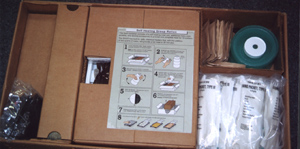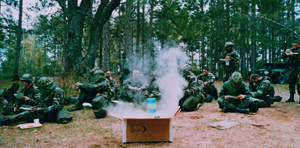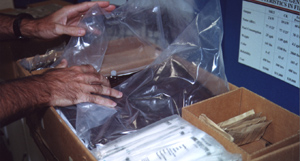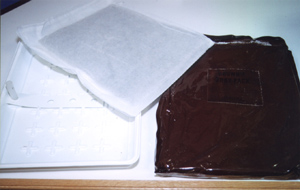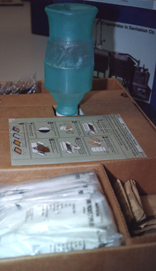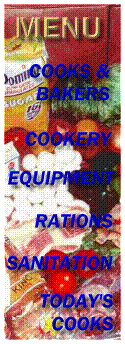
Boxed Kitchen
Self-Heated Meals Fuel Troops in Remote Areas
Without Cooks
Pull the tab, wait about 20 minutes and then unpack the box containing separate heated entrée, vegetable, starch and dessert trays complete with plates, cups, utensils and even Tabasco sauce.
Self-Heated Meals for Remote Site Feeding, informally known as “Kitchen in a Carton,” could make serving a hot meal to troops far away from a base camp that simple. As the military seeks ways of becoming lighter and faster, the self-heated meals look to meet the challenge.
|
|
|
After the top parts are folded away, an eight-step instruction sheet shows the user how to prepare the meal. |
“The military wants to get long on the tooth and short on tail,” said Don Pickard, team leader of Equipment and Energy Technologies for the Department of Defense Combat Feeding Program at the U.S. Army Soldier Systems Center (Natick). “For remote units that may not be issued kitchen capabilities, heat and serve meals, like this ‘Kitchen in a Carton,’ will go a long way toward reducing the logistical tail associated with military field feeding.”
|
|
|
Soldiers rest while an activated container of self-heated meals sends steam into the air. The cartons are ready in about 20 minutes. |
A rectangular box houses the self-heated meals contents, which could be pre-positioned, air dropped or carried by the units to the field. In one version of the product, a tab sticking out of the top cardboard fold when pulled releases water to activate the chemical heaters in each tray. The correct amount of heat is provided to the type of food in each tray stacked in the carton. Another version uses a collapsible water bottle inserted into a nozzle at the top to fill the heating trays.
Plates, cups, utensils, condiments and complementary foods, such as hamburger buns, are stored in a compartment on each side. After the meal, waste products can be returned to the original container for easy, compact disposal. A single carton can feed 12 to 16 soldiers or be adjusted to meet field needs.
|
|
|
After the trays are heated, the cardboard cover is removed and the trays are taken out for serving. |
More than just a logistics problem, serving quality food is a morale issue as well.
Soldiers are now served Unitized Group Rations that are prepared by cooks in a support area and delivered to them, or they are served hot meals using two cooks attached to a unit, which requires a Humvee to carry portable kitchen equipment. Group rations are offered in five breakfast and 10 lunch or dinner selections, and are served as an alternative to Meals, Ready-to-Eat.
Feeding soldiers will become harder as advancements in command, control and communications result in many Army units covering more terrain and being more widely dispersed than ever. Many teams or squads will likely operate remotely from their main unit for an extended time, and supporting these units with food service will be difficult or even dangerous during combat, according to Pickard.
|
|
|
Each tray lies in a pan that contains a heating pack. When water reaches the pack, the heating process begins. |
Self-heated meals are particularly important to the Signal Corps, which can’t be regularly sustained because it would give away the unit’s location on the battlefield.
These meals allow isolated units to serve themselves a hot meal that is compact, lightweight, simple and affordable.
“It eliminates a lot of the logistics,” Pickard said. “You can get rid of the cost and weight, and replace it with one box.”
The idea is that by heating the right amount of high-quality food at the right time and place with a virtually on-demand food service, wasted food will be reduced to fraction of present levels, costs will be drastically reduced, and food acceptance and consumption will increase.
|
|
|
One version of the self-heated meals uses a water bottle that is attached to a tube at the top. |
By 2003, the goal is to complete the design of a self-heated ration and demonstrate field feeding that provides hot food that, for remote sites, cuts food service costs, weight and labor each by 90 percent, and increases food acceptance by at least two points on a nine-point rating scale.
Advances in chemical heating, food processing and polymeric tray packaging have merged to allow the self-heated meals to become possible, said Pickard. Quality will still be a key issue. However, Pickard’s office is closely linked with research into food processing to ensure optimum quality.
The product is currently targeted for military users, but Pickard said the meals could be used for civil emergency or disaster relief, or for camping. Ontro Inc. in Poway, Calif., an innovative developer of self-heated packages, was awarded a research and development contract to develop prototypes of the Natick concepts.
A technical demonstration is planned for 2002 at Fort Irwin, Calif., and Fort Polk, La.
Reprinted from the November-December 2000 issue of the Warrior.
February 2001
| Bulletin Board | Keyword Search |
| Bookstore | Links |
| About Us | Recent Additions |


